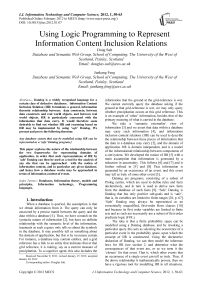Using Logic Programming to Represent Information Content Inclusion Relations
Автор: Doug Salt, Junkang Feng
Журнал: International Journal of Information Technology and Computer Science(IJITCS) @ijitcs
Статья в выпуске: 1 Vol. 4, 2012 года.
Бесплатный доступ
Datalog is a widely recognised language for a certain class of deductive databases. Information Content Inclusion Relation (IIR) formulates a general, information theoretic relationship between: data constructs; between data constructs and real world objects, and between real world objects. IIR is particularly concerned with the information that data carry. It would therefore seem desirable to find out whether IIR and reasoning based on IIR may be implemented by using 'safe' Datalog. We present and prove the following theorem: Any database system that can be modelled using IIR can be represented as a 'safe' Datalog program.} This paper explores the nature of the relationship between the two frameworks for representing domains of application, in order that such representations of IIR by 'safe' Datalog can then be used as a tool for the analysis of any site that can be approached with the notion of information content, and in particular any given database, and hence how a database works may be approached in terms of information content of events.
Databases, Information theory, models and principles, Information technology, Programming languages
Короткий адрес: https://sciup.org/15011653
IDR: 15011653
Список литературы Using Logic Programming to Represent Information Content Inclusion Relations
- X. Wu and J. Feng, “A framework and implementation of information content reasoning in a database,” WSEAS Trans. Info. Sci. and App., vol. 6, no. 4, pp. 579–588, 2009.
- J. Feng, Y. Wang, and S. Wang, “Causes and types of connection traps in data schemata,” WSEA Transactions on Information Science and Applications, vol. 4, pp. 1303 –1311, July 2007.
- L. Floridi, “Philosophical conceptions of information,” in Formal Theories of Information: From Shannon to Semantic Information Theory and General Concepts of Information, pp. 13–53, Springer-Verlag, 2009.
- L. Floridi, “Is information meaningful data?,” Philosophy and Phenomenological Research, vol. 70, no. 2, pp. 351–370, 2005.
- K. Xu, J. Feng, and M. Crowe, “Defining the notion of “information content” and reasoning about it in a database,” Knowledge and Information Systems, vol. 18, pp. 29–59, Jan. 2009.
- F. I. Dretske, Knowledge and the Flow of Information. Cambridge University Press, new edition ed., May 1999.
- W. Hu and J. Feng, “Considering norms and signs within an information Source-Bearer-Receiver (S-B-R) framework,” in Virtual, Distributed and Flexible Organisations, pp. 183–184, Springer Netherlands, 2005.
- K. Xu, The Notion of “Information Content of Data” for Databases. Doctoral thesis, University of the West of Scotland, July 2009.
- R. Elmasri and S. B. Navathe, Fundamentals of Database Systems. Benjamin-Cummings Publishing Company, Subs of Addison Wesley Longman, Inc, 2nd revised edition ed., Feb. 1994.
- M. Dahr, Deductive Databases. International Thomson Computer Press, Dec. 1996.
- A. Shimojima, On the Efficacy of Representation. PhD thesis, Indiana University, May 1996.
- J. Barwise and J. Seligman, Information Flow: The Logic of Distributed Systems. Cambridge University Press, July 1997.
- H. Xu and J. Feng, “Towards a definition of the “information bearing capability” of a conceptual data schema,” in Systems Theory and Practice in the Knowledge Age, pp. 431–438, Springer, 1st ed., June 2002.
- K. Devlin, Goodbye Descartes: End of Logic and the Search for a New Cosmology of the Mind. John Wiley & Sons, new edition ed., Mar. 1998.
- P. J. Cameron, Sets, Logic and Categories (Springer Undergraduate Mathematics). Springer, illustrated edition ed., Jan. 1999.
- S. Zhu, Reasoning about the information content of data: The use of ontology. PhD thesis, University of the West of Scotland, Aug. 2009.
- X. Wu, An Architecture of System of ’Information Content’ Reasoning in Databases. Masters dissertation, University of the West of Scotland, Dec. 2008.
- S. Zhu and J. Feng, “Using an ontology to help reason about the information content of data,” Journal of Software Engineering and Applications, vol. 3, pp. 629–643, July 2010.
- C. Zaniolo, S. Ceri, C. Faloutsos, R. T. Snodgrass, V. Subrahmanian, and R. Zicari, Advanced Database Systems. Morgan Kaufmann, May 1997. Part III.
- T. Eiter, G. Gottlob, and H. Mannila, “Disjunctive datalog,” ACM Trans. Database Syst., vol. 22, no. 3, pp. 364–418, 1997.
- F. Sáenz-Pérez, “Datalog educational system v1.6.2 user’s manual,” 2004. Technical Report SIP 139-04.
- S. Abiteboul, R. Hull, and V. Vianu, Foundations of Databases. Addison Wesley, facsimile ed., Feb. 1995.
- Das, Deductive Databases and Logic Programming. Addison Wesley, July 1992.
- M. Arenas and L. Libkin, “An information-theoretic approach to normal forms for relational and XML data,” J. ACM, vol. 52, pp. 246–283, Mar. 2005.
- T. T. Lee, “An Information-Theoretic analysis of relational databases part i: Data dependencies and information metric,” IEEE Trans. Softw. Eng., vol. 13, no. 10, pp. 1049–1061, 1987.
- T. T. Lee, “An Information-Theoretic analysis of relational databases part II: information structures of database schemas,” IEEE Trans. Softw. Eng., vol. 13, no. 10, pp. 1062–1072, 1987.
- J. Feng and D. Salt, “Information content inclusion relation and its use in database queries,” Journal of Software Engineering and Applications, vol. 3, pp. 255–267, Mar. 2010.
- T. M. Connolly and C. E. Begg, Database Systems: A Practical Approach to Design, Implementation and Management. Addison Wesley, 5 ed., Apr. 2009.
- H. Xu and J. Feng, “The “how” aspect of information bearing capability of a conceptual schema at the path level,” in 7th Annual Conference of the UK Academy for Information Systems, UKAIS, vol. 9, (Leeds), pp. 209–215, 2002.
- M. Bremer and D. Cohnitz, Information and Information Flow: An Introduction. ontos verlag, July 2004.
- K. Devlin, Logic and Information. Cambridge University Press, Sept. 1995.
- B. C. Pierce, Basic Category Theory for Computer Scientists. MIT Press, Sept. 1991.


